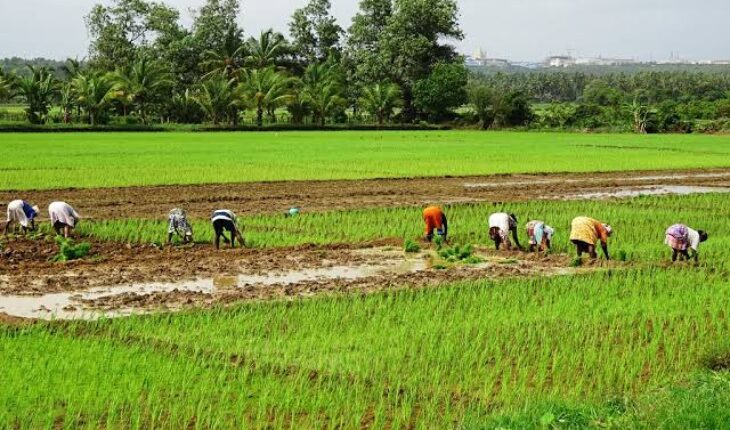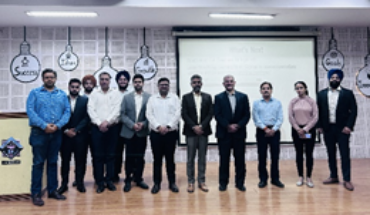Goa : The monsoons have arrived in full force in Goa with fields becoming inundated alongside flooded roads, making vehicular and public traffic movement virtually impossible despite various control measures by the concerned authorities.
But the indomitable spirit of the farmers prevail as they come out in force where, undeterred by the pounding rain and probability of lightning strikes, they concentrate on planting their paddy crops in the flooded fields.

A.P.Sinha, Director, Farlense Group
However, agriculture credit in the Indian context –where the on-ground situation seems to remain the same – is witnessing a changing scenario, though its slow pace is unlikely to definitely contribute to doubling the farmers’ income by 2025. So making formal agriculture credit a reality in this country is the need of the hour, according to A.P.Sinha, Director, Farlense Group.
“Agriculture credit has been classified as priority sector lending by the Indian government – about 45% of PSL is supposedly for agricultural sector. This includes credit for farmers – for agri-activities, agri-infrastructure (warehouse, cold storage, mandis, etc.), and ancillary (food processing, etc.). This also includes lending to NBFC’s, co-operatives, co-op banks working in the field of agriculture, in close proximity with the farmers.”
“However, more than 40% of agriculture credit is still estimated to be coming from the informal sector, leaving farmers vulnerable to high lending rates.[i] Even then, the balance 60% includes the lending to industries in agricultural input and output, which are supposedly considered “safe” by banks (the current state of NPA’s may lay waste to the banks’ assumption that industry lending was safe).”
“The farmer is an entrepreneur. The risk and rewards of his investment are solely his. The enhancement of agricultural productivity world-wide creating surplus, the populist policies of successive governments to keep food inflation low combined with the increase in input costs has seen his margins shrink over a period of time – to now where it can be said that +farming in India is turning non-profitable and economically unfeasible. More so for small and marginal farmers – who will have difficulty in sustaining the pressures being brought about by globalisation.+ How long will we be able to keep the WTO pressures at bay? Unless drastic measures are taken, the largest body of entrepreneurs in this country stands to become unprofitable in the future.”
“In focusing on challenges persisting in Agricultural Credit, the main generic problem still is the profitability (or the lack thereof) of agriculture. If agriculture is profitable enough, the farmer may turn from an overall borrower to a lender. There is a limit to his future investment for extra profits (if any) – most definitely limited by the shrinking of available agricultural land. The other generic problem is the inherent risk his crops face – and the mitigation factors available today. The insurance cover offered today are summarily insufficient, despite government schemes such as Fasal Bima Yojana.”
“In the informal sector – where the farmer most often borrows from – the main problem is the high rates of interest. This can go as high as 36% for small and marginal farmers on an annualised basis. Then, there are legacy loans – sometimes going over generations, and again at prohibitive rates of interest. Last, but not the least is that the system is full of malpractices – fuelled by the illiteracy of farmers, especially with respect to financial calculations.”
“The formal sector fares little better than the informal one. Most of the farmers, especially marginal and landless ones – which require the credit the most – are “ineligible” as per banking norms. The high risk of agriculture coupled with lack of insurance (loan linked or otherwise) makes them further ineligible. The basic financial products are unavailable, the advanced financial tools like the forward markets (for mitigation of price risk) and warehouse receipts are still to take hold. The state government in their populist moves periodically go for farm loan waivers – making the bank and financial institutions warier of farmer loans. Formal or informal sector – farmer is anyway in a bind.”
“The way forward lies in concentrating on what can be done with what we have, and can actually be implemented. There are few interlinked and immediate measures we can take to formalise the credit to farmers. The solutions proposed here, mainly, have been made possible by the evolving technologies – the information age, the mobile revolution, Artificial Intelligence etc.”
“The most important step would be to link the farmer to the market – to increase his income. The link to the market – physical for product and virtual for information – shall not only help him grow what the market demands, it will also help him realise a better price. Demand-based production will lead to stable prices while contract farming and its enforcement will lead to reduction of price risks. Start-ups in this field can act as important catalysts, addressing inefficiencies in traditional banking systems and enhancing market linkage for the farmers, effectively filling the institutional gap.”
“A comprehensive multipartite linkage between farmer, credit provider, insurance and the buyer of produce is a must. In case of a crop failure – the insurer can directly pay up the credit provider – reducing the risk on the debt. In case of a normal crop, the buyer can credit the proceeds of the sale to the farmer’s bank account – with the credit provider – again reducing the debt risk. This reduction in risk for the credit provider shall encourage the institutions to provide credit, and hopefully bring down the interest rates.”
“To increase the use of advanced financial products like forward trades and the warehouse receipts, the first step would be a nationwide standardisation of quality for all commodities (a host of commodities have been standardised, but many are still pending) – possibly linked to international standards. This will make the financial tools tradable internationally, giving access to low cost financing, eventually, low interest reaching the farmers.”
“Once standardisation has been done, forward linkages and contract farming can allow of significant amount of produce sale before sowing. These then can act as collaterals for the financial institutions. Similarly warehouse receipts can act as collaterals for FIs. Collateralised loans can attract lower rates of interest. All forward deals and warehouse receipts data should be centralised (electronic) and made available to lenders.”
“Agricultural credit should be season/crop based – instead of financial year. Financial institutions should develop customized financial products tailored to the specific needs of farmers. For instance, specialized loans for agricultural inputs or equipment leasing arrangements must be designed to align with the seasonal cash flows and production cycles of farmers. Clearance of accounts or payments should be done 45-60 days after harvest. New crop loan should be dependent on previous loan clearance, etc.”
“Like all consumers/organisations, farmers credit rating should be in lenders/public domain and be linked to the availability of loan and rate of interest.”
“All these measures listed above already have a legal framework, and are being practiced in some measures, and for some crops. Institutionalisation of these measures and their rapid deployment on a reliable IT backbone can change the face of credit for the Indian farmer. Further, there is a dire need to focus on providing farmers with the necessary skills and knowledge to navigate digital platforms and access financial products through increased financial literacy along with scaling and replicating successful models in new regions to extend the benefits of inclusive finance to more farmers.”






